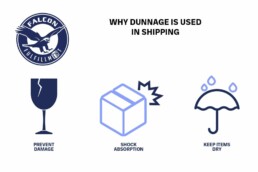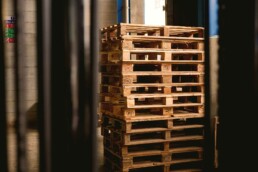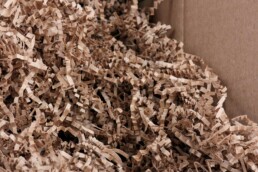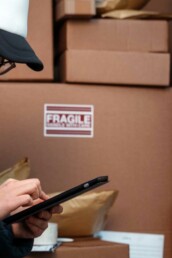Dunnage – What it is and why you need it
Protecting items during shipping is crucial to ensure they arrive undamaged. Statistics show that 20% of consumers return items because the consumers received damaged products. Use the right mix of dunnage to satisfy consumers’ growing expectations and to safeguard your financial investment. Working with a fulfillment partner expert in shipping, packing, and returns will help you determine what types to use. Let’s uncover what dunnage is and why you need it.
What is dunnage?
Dunnage is the packing material that protects items during shipping and handling. Dunnage isn’t a common word consumers know, but it is an integral part of fulfillment. Companies spend a lot of money and time deciding what type and quantity of materials you need for products to arrive safely at their intended destination. Dunnage can include packing peanuts, bubble wrap, paper, and even wooden crates affixed to large items and appliances.
Why dunnage is used in shipping?

- To prevent damage – the main reason is to avoid damaging the shipped item. Imagine sending an antique vase from Europe in a box without bubble wrap, paper fill, or packing peanuts. It is not likely that the vase would arrive in one piece.
- To keep items dry – another reason dunnage is used in shipping is to keep the product from getting wet. Packages moving from shipping containers, warehouses, and trucks are often exposed to the elements. Therefore, dunnage ensures that the product doesn’t arrive in a soggy mess, even if the outer box gets wet.
- Shock absorption – parcels get dropped, pushed, bounced, and pressed during transport. Dunnage helps to absorb the vibration and minimize the jostling of the product in the package.
What types of dunnage are there?
Solid dunnage materials.

Solid dunnage materials are used for heavy, highly valuable, or oversized items. The type or combinations of materials used depends on the product material, shape, size, and shipping container. However, there are a few common solid materials used in shipping.
Wood
Wood is a heavyweight material. It is readily available, and it is a renewable resource. However, many ports and countries impose additional customs duties on wood dunnage, and others will not allow it all because of foreign pest concerns.
Solid Plastics
Solid plastic dunnage is one of the best materials for high-value goods, heavy items, or oddly shaped products. You can form it into any shape and it is made of high-density polyethylene (HDPE). This type of material is expensive compared to other options but is worth the investment when you consider the replacement costs of high-value items and large machinery.
Steel
People use steel for another solid option when shipping heavy goods or partitioning items within a single container. This type of dunnage is expensive, so you typically use it for high-value goods.
Soft dunnage materials.

People use soft dunnage when shipping lightweight and smaller items. People often use a combination of solid and soft when shipping freight. For example, a supplier might send a pallet of electronics using solid plastic pallets, containing each item in corrugated cardboard, bubble wrap, and shrink-wrapped. Consider the size, shape, material, and value of the products shipped when deciding which type of dunnage best safeguards them in transit.
Bubble Wrap
Bubble wrap isn’t just your child’s favorite popping toy but also a favorite in the shipping industry. This dunnage is inexpensive and does a great job protecting fragile items like glass and china. You can also reuse bubble wrap many times, provided you haven’t popped the bubbles!
Air Pillows
Air pillows are an excellent solution, especially to fill gaps in a package. You primarily use these to create barriers to keep a product from shifting or sliding during transport. They are lightweight, so they don’t add much to the shipping costs.
Foam
People often use foam to safeguard electronics or other items that have sharp edges. It also pads sharp, fragile, or sensitive things like medical supplies.
Kraft Paper
Kraft paper is a great option because it is a renewable resource, cheap, and works. You often find items that require strength and durability packed in kraft paper. If you have ever received an item packed in crinkled paper, this was kraft paper packaging.
Corrugated Paper
Corrugated paper is one of the best and most commonly used forms of dunnage. Its high-tech construction allows it to carry a variety of weights, and it is excellent for keeping items dry and wicking away moisture.
Custom Dunnage
Some products require a custom solution. Working with a dunnage provider for a custom solution might be necessary. Alternatively, you want a custom packaging solution that includes branded packaging and creates a memorable unboxing experience. Falcon Fulfillment specializes in this.
Beginner’s Guide to Third-Party Logistics (3PL)
The world of e-commerce is always changing, therefore understanding the roll of Third-Party Logistics is integral to keeping up. In light of this our beginner’s guide to third-party logistics (3PL) will delve into the essential aspects, offering insights into fulfillment services, warehousing, and much more.
Read More…
3PL fulfillment companies are experts in protecting items during shipping. No matter whether you ship forklifts or champagne flutes, you will use dunnage to protect those items. If you want to learn more about how partnering with Falcon Fulfillment can help you select the best packaging options for your business, get in touch today.





